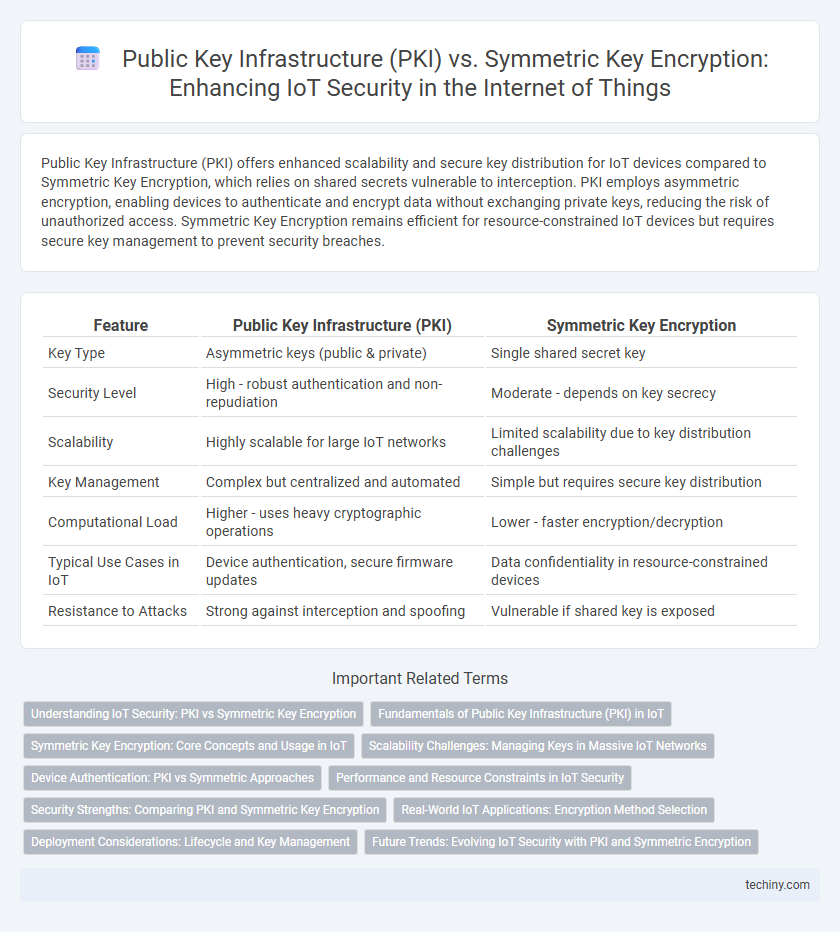Public Key Infrastructure (PKI) offers enhanced scalability and secure key distribution for IoT devices compared to Symmetric Key Encryption, which relies on shared secrets vulnerable to interception. PKI employs asymmetric encryption, enabling devices to authenticate and encrypt data without exchanging private keys, reducing the risk of unauthorized access. Symmetric Key Encryption remains efficient for resource-constrained IoT devices but requires secure key management to prevent security breaches.
Table of Comparison
| Feature | Public Key Infrastructure (PKI) | Symmetric Key Encryption |
|---|---|---|
| Key Type | Asymmetric keys (public & private) | Single shared secret key |
| Security Level | High - robust authentication and non-repudiation | Moderate - depends on key secrecy |
| Scalability | Highly scalable for large IoT networks | Limited scalability due to key distribution challenges |
| Key Management | Complex but centralized and automated | Simple but requires secure key distribution |
| Computational Load | Higher - uses heavy cryptographic operations | Lower - faster encryption/decryption |
| Typical Use Cases in IoT | Device authentication, secure firmware updates | Data confidentiality in resource-constrained devices |
| Resistance to Attacks | Strong against interception and spoofing | Vulnerable if shared key is exposed |
Understanding IoT Security: PKI vs Symmetric Key Encryption
Public Key Infrastructure (PKI) enhances IoT security by using asymmetric cryptography, enabling secure device authentication and scalable key management across vast networks. Symmetric key encryption, while faster and less resource-intensive, requires secure key distribution and is vulnerable if a single key is compromised. Balancing PKI's robust identity verification with symmetric encryption's efficiency is crucial for protecting IoT ecosystems against unauthorized access and data breaches.
Fundamentals of Public Key Infrastructure (PKI) in IoT
Public Key Infrastructure (PKI) in IoT enables secure device authentication and data encryption through asymmetric cryptography using a pair of public and private keys. PKI manages digital certificates issued by trusted Certificate Authorities (CAs) to verify device identities and establish encrypted communication channels. This framework enhances IoT security by ensuring data integrity and confidentiality across distributed networks without relying on pre-shared symmetric keys.
Symmetric Key Encryption: Core Concepts and Usage in IoT
Symmetric Key Encryption in IoT involves using a single shared key for both encryption and decryption, enhancing speed and efficiency crucial for resource-constrained devices. This method supports secure communication between IoT sensors and gateways by minimizing computational overhead compared to Public Key Infrastructure (PKI). Common algorithms like AES are optimized for low-power IoT hardware, ensuring confidentiality and integrity in large-scale deployments.
Scalability Challenges: Managing Keys in Massive IoT Networks
Public Key Infrastructure (PKI) offers enhanced scalability for massive IoT networks by facilitating secure key distribution and management through asymmetric cryptography, enabling devices to independently authenticate and establish secure channels. Symmetric Key Encryption, though computationally efficient, faces significant scalability challenges due to the need for secure key sharing and storage across a vast number of IoT devices, increasing risks of key compromise. Managing millions of symmetric keys in large-scale IoT deployments often results in complex key lifecycle management and higher operational overhead compared to PKI solutions.
Device Authentication: PKI vs Symmetric Approaches
Public Key Infrastructure (PKI) offers scalable and robust device authentication in IoT by leveraging asymmetric cryptography, enabling secure key distribution and non-repudiation. Symmetric key encryption, while faster and less resource-intensive, struggles with key management and scalability due to the need for shared secret keys among devices. PKI facilitates dynamic and trusted device authentication in large-scale IoT deployments, making it more suitable for diverse and evolving networks compared to the static nature of symmetric approaches.
Performance and Resource Constraints in IoT Security
Public Key Infrastructure (PKI) offers robust security through asymmetric cryptography but often demands higher computational power and memory, making it less suitable for resource-constrained IoT devices. Symmetric key encryption provides faster processing speeds and lower energy consumption, aligning better with the limited processing capabilities of typical IoT sensors and actuators. Balancing security strength with performance efficiency is critical in selecting encryption methods that accommodate the scalability and heterogeneity of IoT ecosystems.
Security Strengths: Comparing PKI and Symmetric Key Encryption
Public Key Infrastructure (PKI) offers robust security through asymmetric encryption, enabling secure key distribution and non-repudiation crucial for large-scale IoT deployments. Symmetric key encryption provides faster processing and lower resource consumption, making it suitable for real-time data protection in constrained IoT devices but requires secure key management to prevent vulnerabilities. Evaluating security strengths reveals that PKI enhances trust with scalable authentication, while symmetric keys excel in efficiency, often necessitating hybrid approaches for balanced IoT security.
Real-World IoT Applications: Encryption Method Selection
In real-world IoT applications, selecting between Public Key Infrastructure (PKI) and symmetric key encryption hinges on device capability and security requirements. PKI enables scalable, secure device authentication and key exchange, ideal for large IoT networks with diverse endpoints. Symmetric key encryption offers faster processing and lower power consumption, suitable for resource-constrained IoT devices needing efficient data confidentiality.
Deployment Considerations: Lifecycle and Key Management
Public Key Infrastructure (PKI) offers scalable lifecycle management through automated certificate issuance, renewal, and revocation, making it ideal for large-scale IoT deployments with dynamic device populations. Symmetric Key Encryption requires manual or semi-automated key distribution and rotation, presenting challenges in secure key storage and scalable management across thousands of IoT endpoints. Effective deployment demands careful evaluation of IoT device capabilities, network architecture, and security policies to balance operational complexity and robust lifecycle key management.
Future Trends: Evolving IoT Security with PKI and Symmetric Encryption
Future trends in IoT security emphasize integrating Public Key Infrastructure (PKI) and symmetric key encryption to enhance device authentication and data confidentiality. PKI offers scalable identity management and supports secure key distribution, while symmetric encryption ensures efficient real-time data protection with low computational overhead. Emerging hybrid models combine both techniques to address the increasing complexity and resource constraints in IoT environments, enabling robust and adaptive security frameworks.
Public Key Infrastructure (PKI) vs Symmetric Key Encryption (IoT Security) Infographic

 techiny.com
techiny.com